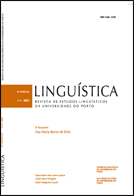Das inferências à interpretação recursiva na leitura do texto literário em L2
Resumo
No campo da leitura em L2, o texto literário surge como um patamar difícil de vencer, mesmo nos níveis de proficiência mais altos, por não depender apenas de um certo nível de desempenho linguístico. O texto questiona, nesse sentido, a influência que o processamento de cariz inferencial (Kintsch 1998; Koda 2004) tem na compreensão profunda (Bernhardt 1991: 2011) e na distância que este género textual exige do leitor (Armstrong 2013; Olson 1994). Apontam-se vantagens da leitura literária no processo de aprendizagem de uma L2, não esquecendo que esses benefícios abrangem mais do que a competência linguística, na medida em que imprimem uma marca na flexibilidade mental do leitor que se vê levado a fugir de rotinas cognitivas e contribuem para a reserva cognitiva futura (Armstrong 2013; Paradis 2004; Pinto 2010; 2013).
Referências
Andrews, E. 2014. Neuroscience and multilingualism. Cambridge: Cambridge University Press.
Armstrong, P. B. 2013. How literature plays with the brain: The neuroscience of reading and art. Baltimore: Johns Hopkins University Press.
Barthes, R. 2009. O prazer do texto precedido de Variações sobre a escrita. Lisboa: Edições 70, Lda.
Bernhardt, E. 1991. Reading Development in a second language: theoretical, empirical, and classroom perspectives. New Jersey: Ablex Publishing Corporation.
Bernhardt, E. 2011. Understanding Advanced Second Language Reading. New York: Routledge, Taylor and Francis Group.
Coleridge, S. T. 1817. Biographia literaria. Disponível em https://web.english.upenn. edu/~mgamer/Etexts/biographia.html (último acesso a 20/01/2021).
Cook, V. 2002. Portraits of the L2 user. Buffalo, N.Y.: Multilingual Matters Lda.
Damásio, A. 2013. O sentimento de si. Corpo, emoção e consciência. Lisboa: Temas e Debates – Círculo de Leitores.
Djikic, M.; Oatley, K.; Moldoveanu, M. C. 2013. Opening the closed mind: the effect of exposure to literature on the need for closure. Creativity Research Journal, 25 (2): 149-154.
Emig, J. 1977. Writing as a mode of learning. College Composition and Communication. 28(2): 122-128.
Emig, J. 1983. The web of meaning. Upper Montclair, N.J.: Boynton/ Cook Publishers, Inc.
Goodman, K. 1996. On Reading. A common sense look at the nature of language and the science of reading. Portsmouth: Heinemann.
Goodman, K.; Goodman, Y.; Flores, B. 1979. Reading in the bilingual classroom: literacy and biliteracy. InterAmerica Research Associates, Inc.
Haber, J. 2020. Critical thinking. Cambridge, MA: MIT Press.
Hirvela, A. 2001. Connecting reading and writing through literature. In D. Belcher & A. Hirvela (Eds.) Linking literacies. Perspectives on L2 reading-writing connections. Michigan: The University of Michigan Press.
Hornberger, N. 2004. The continua of biliteracy and the bilingual educator. Educational linguistics in practice. International Journal of Bilingual Education and Bilingualism. 7 (3): 155-171.
Ireland, M.E.; Pennebaker, J.W. 2010. Language Style Matching in Writing: Synchrony in Essays, Correspondence, and Poetry. Journal of Personality and Social Psychology. 99 (3): 549–571.
Kang, Z. 2020. Usage-based instruction, systems thinking, and the role of Language Mining in second language development. Language Teaching: 1-16.
Kaplan, J.T.; Gimbel, S.I; Dehghani, M.; Immordino-Yang, M. H.; Sagae, K.; Wong, J. D.; Tipper, C. M.; Damasio, H.; Gordon, A. S.; Damasio, A. 2017. Processing narratives concerning protected values: A cross-cultural investigation of neural correlates. Cerebral Cortex. 27: 1428-1438.
Kintsch, W. 1998. Comprehension. A paradigm for cognition. Cambridge: Cambridge University Press.
Koda, K. 2004. Reading and language learning: Crosslinguistic constraints on second language reading development. Language Learning. 57 (1): 1-44.
Krashen, S. 1985. The power of reading. In Inquiries and insights. Selected essays. Hayward, CA: Alemany Press.
Olson, D. R. 1994. The world on paper. Cambridge: Campridge University Press.
Paradis, M. 2004. A Neurolinguistic Theory of Bilingualism. Amsterdam/ Philadelphia: John Benjamins Publishing Company.
Pinto, M. da G. L. C. 2010. A leitura/ escrita na universidade e para lá dos seus muros. In M.ª J. Marçalo; M.ª C. Lima-Hernandes; E. Esteves; M.ª C. Fonseca; O. Gonçalves; A. L. Vilela; A. A. Silva (Eds.) Língua portuguesa: ultrapassar fronteiras, juntar culturas.
Évora: Universidade de Évora.
Pinto, M. da G. L. C. (2013). A leitura e a escrita: um processo conjunto assente numa inevitável cumplicidade. Letras de Hoje. 48 (1): 116-126.
Rosenblatt, L.M. 1960. Literature: the reader’s role. The English Journal. Vol. 49 (5), p. 304-316.
Sacks, O. 1985. The man who mistook his wife for a hat and other clinical tales. New York: Summit Books.
Spack, R. 1985. Literature, reading, writing, and ESL. Bridging the gaps. TESOL Quarterly. 19 (4): 703-725.
Sperber, D. & Wilson, D. 1995. Relevance: Communication and cognition. Malden: Blackwell Publishing.
Shakespere, W. 1597. Romeo and Juliet. Disponível em http://shakespeare.mit.edu/romeo_juliet/full.html (Último acesso a 1 de fevereiro de 2021).
Smith, F. 1994. Understanding reading. A Psycholinguistic analysis of reading and learning to read. New Jersey: Lawrence Erlbaum Associates, Inc. Publishers.
Stanovich, K. E. 1986. Matthew effect in reading. Some consequences of individual differences in the acquisition of literacy. Research Quarterly. 21 (4): 360-407.
Stanovich, K. E. 2000. Progress in understanding reading: scientific foundations and new frontiers. New York: The Guilford Press.
Vigotski, L. 2007. Pensamento e Linguagem. Lisboa: Relógio D’Água Editores.
Downloads
Publicado
Edição
Secção
Licença
Direitos de Autor (c) 2021 Linguística: Revista de Estudos Linguísticos da Universidade do Porto

Este trabalho encontra-se publicado com a Creative Commons Atribuição-NãoComercial 4.0.



